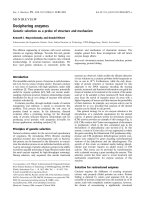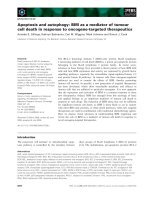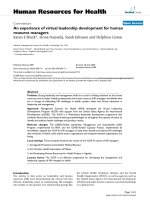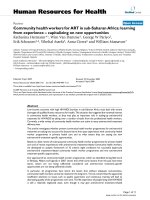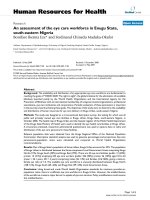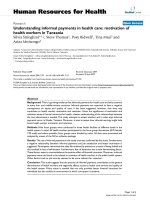Báo cáo sinh học: "An NIH intramural percubator as a model of academic-industry partnerships: from the beginning of life through the valley of death" pptx
Bạn đang xem bản rút gọn của tài liệu. Xem và tải ngay bản đầy đủ của tài liệu tại đây (184.35 KB, 4 trang )
COM M E N TAR Y Open Access
An NIH intramural percubator as a model of
academic-industry partnerships: from the
beginning of life through the valley of death
Michael R Emmert-Buck
Abstract
In 2009 the NIH publicly announced five strategic goals for the institutes that included the critical need to translate
research discoveries into public benefit at an accelerated pace, with a commitment to find novel way s to engage
academic investigators in the process. The emphasis on moving scientific advancements from the laboratory to the
clinic is an opportune time to discuss how the NIH intramural program in Bethesda, the largest biomedical
research center in the world, can participate in this endeavor. Proposed here for consideration is a percolator-
incubator program, a ‘percubator’ designe d to enable NIH intramural investigat ors to develop new medical
interventions as quickly and efficiently as possible.
Introduction
I have sometimes thought that, in order to be a good
minister, it was necessary to leave the ministry. The
profession is antiquated. In an altered age, we wor-
ship in the dead forms of our forefathers.
- Ralph Waldo Emerson
The present proposal is in response to the recent call
by the NIH to develop new methods that f acilitate the
translational resea rch process [1-3]. At the outset, it is
imperative to crystallize what is being articulated - not
so much a business model or administrative structure
but an environment where academic percolation and
business incubation occur together, back and forth,
short-term and long-term, without artificial walls of
separation, and where investigators are enabled to use
their knowledge to rapid ly move discoveries to the pub-
lic. The percubator is a partnership between government
and business that incorporates the best of both to
responsibly but urgent ly translate research findings into
clinical interventions. Importantly, the program corrects
a fundamental engineering problem present in most
translational research systems - inefficient bi-directio nal
movement of individual researchers between academic
and commercial silos.
Discussion
Concept uall y, the program will consist of the seven ele-
ments listed in Figure 1. Some might argue a percubator
blurs an important distinction between basic science
and private sector activities, but this is not accurate.
Academia is a scintillating environment where in vestiga-
tors can ponder a nd question nature irrespective o f an
immediate utility - it’s a percolator of ideas, inventions
and biologica l discoveries, a place where one can ‘ won-
der if and wonder how’. In contrast, companies focus
primarily on applied science, taking early concepts from
the percolation phase and incubating them through
early testing, and then into the competitive world of the
marketplace and clinic. The goal of the percubator is
not to meld these two modes of thinking together;
rather, it is to remove the barrier that separates them
and allow free and unfettered movement of investigators
between t he two, anticipating that it will be synergistic
to do so and even n ecessary in some instances, espe-
cially considering the arduous path from labo ratory to
the public. Development of a drug or device is not a lin-
ear and unidirectional movement of a single idea, but is
an iterative and parallel movement of ma ny related sub-
ideas and sub-projects occurring at various points and
in different directions along the translational vector.
Repetitive cycles must be performed; from percolator to
incubator and then back to the drawing board (percola-
tor) again to solve this problem or that. A translational
Correspondence:
Maryland, USA
Emmert-Buck Journal of Translational Medicine 2011, 9:54
/>© 2011 Emmert-Buck; licensee BioMed Central Ltd. This is an Open Access article distributed under t he terms of the Creative
Commons Attribution License ( which permits unrestricted use, distributio n, and
reproduction in any me dium, provided the original work is properly c ited.
system of ‘ academia discovers over here and then b io-
tech or pharma commercializes over there’ is not neces-
sarily ideal. The percubator will a llow these activities to
occur in one place, under the long-term and sustained
direction of one ind ividual, and will augment the meth-
ods that are currently in place.
At present, the barrier between percolation and incuba-
tion in the NIH intramural program is often close to
impermeable. In contrast, universities and many research
institutions contain a semi-permeable barrier that allows
academic investigators to work in both arenas, albeit in
separate locations, with different people and not always
with control over scientific direction once the work
‘leaves the lab’. The proposed NIH percubator program
pushes this concept one step further by eliminating the
barrier altogether, but at the same time respecting and
building upon t he distinctio n and uniqueness of acade-
mia and the private sector. A likely outcome is that inves-
tigators in the program will continue to focus on basic
research as a primary function, but when the time is
right they will quickly move a discovery to their
innovative small company and into early incubation,
facilitating testing of more ideas for translational poten-
tial than is done now, and then further developing drugs
or devices that show promise, all the while overseeing the
process with the depth of field that arises naturally from
a binocular science-business view. Moreover, participat-
ing first-hand will improve investigators’ savvy with
respect to the needs of the ma rket, which in turn will aid
in assessing the translational potential of ideas that are
still in the percolation phase.
The NIH intramural program is an ideal test site for
such new translational research approaches, percubator
or other. Novel systems can be evaluated in an open
and transparent manner, with successful methods
expanded upon and unsuccessful ones closed out for
good cause based on empirical data. Beyond improving
the translational efficiency of the intramural program,
these controlled e xperiments may help inform the pro-
cess more genera lly, providing valuable information for
other government departmen ts, universities, and non-
profit institutions [4].
Intramural investigators will be permitted to license inventions or discoveries
made in their NIH laboratories and to form companies for commercialization,
while remaining intramural employees
NIH will maintain control and oversight of licensed intellectual property,
ensuring that investigators actively translate to the public in a transparent an
d
ethically responsible manner
Investigators will be permitted to utilize their intramural laboratories as
locations for their company to enable seamless integration of efforts
The program will not require new funding, as investigators will utilize current
laboratory space and resources
NIH will collect royalty payments on all successful projects and these monies
will be funneled back into biomedical research; and, investigators will subsidize
their own salaries and research support as their companies develop
NIH as an institution will carefully evaluate the effectiveness of the percubator
as a general method for supporting research and delivery in government and
other settings
The percubator program will provide entrepreneurship training for students,
fellows, and investigators, with the goal of producing a cadre of researchers
who can translate laborator
y
and clinical advances into public bene
f
it
Figure 1 Elements of an NIH intramural percubator program.
Emmert-Buck Journal of Translational Medicine 2011, 9:54
/>Page 2 of 4
Direction and Drive
After a new drug or medical device is percolated to life
and progresses through the early incubation phase it
must then traverse the so-called valley of death - from
promise to real delivery - from drug candidate to effec-
tive therapeutic - from prototype to useful product.
Most translational efforts die here and there a re multi-
ple financial, scientific a nd sociological rea sons for this
phenomenon [5-8]. To help overcome these difficulties,
the new percubator program offers two important ele-
ments to facilitate this journey in the intramural pro-
gram; direction and drive.
Direction
Creating effective new therapies, diagnostics or medical
devices is a challenging and even audacious objective.
Withtheremarkablecomplexityofhumanphysiology
and related pathogenesis, and the difficulty in rational
intervention even when disease etiology is known, it is
perhaps not surprising t he number of FDA approved
agents is dwindling. At the current pace of therapeutic
development the on-going transition from ‘screening for
drugs’ to ‘science-based design of drugs’ maybeacen-
tury-long endeavo r not a decades-long one. Mindful of
the enormity of the undertaking and the urgent needs of
our patients, the requirement for a highly efficient trans-
lational research system becomes apparent.
Enabled by the percubator program, intramural
investigators could provide novel and distinctive trans-
lational roadmaps related to their diseases-of-interest,
a critical contribution given the value of academic dis-
covery in the drug development process [9-11]. As
company decision-makers they would be positioned to
set direction for moving interventions from laboratory
to patient, including original paths-less-traveled based
on their expertise and knowledge base. The safe harbor
of the percubator will provide both the short-term and
long-term resource support to go from start to finis h,
alone or in a later-stage, de-risked partnership with
other companies - down into the valley of death,
across the basin, and up the steep grade of the oppo-
site hill. For drug development, the percubator could
enhance important activities that are currently endan-
gered by market forces. As one example, integrated
academic-commercial scrutiny of biological mechan-
isms of lead compounds could be an important niche
for companies in the percubator to fill when the target
protein or pathway is the subject of an investigator’s
lifelong investigation. As a second example, new medi-
cal interventions for rare or neglected diseases would
be an excellent outcome of the percubator program.
Since the aim is to improve human health and not
necessarily to develop a ‘blockbuster drug’ ,companies
in this uniquely blended academic-private sector envir-
onment may feel freer to pursue projects with a less
attractive market, especially when they dovetail with
investigators’ basic science interests.
This latter scenario may be an important feature of
the percubator, particularly in light of today’ susual
translational approach: a) academia hands off an appli-
cation to the private sector only if and when i t meets a
threshold of projected revenues; b) new research find-
ings are published in an academic journal with the hope
that the information is eventually of use to the private
sector and hence the public. Both of these m ethods are
productive and appropriate of course; however, they
neglect certain kinds of activity that the percubator
could support - for example, a ‘ high benefit-low profit’
translational route - development of tangible p roducts
that will advance human health but will generate only
modest or minimal financial returns. To become a rea-
lity these therapie s, devices, or diagnosti cs will require a
nove l kind of company to produce t hem, within a fund-
ing environment that supports and values such activities.
The recent development and increasing popularity of
low-profit limited liability companies (L3Cs), business
entities with both a social and an economic agenda,
represents new thinking along these lines and could
serve as a template for commercializ ation efforts in the
percubator [12,13]. And as a practical matter, designat-
ing percubator investigators and their companies as
‘co ntractors and contract companies’ would be a simple
route to initiating a pilot program in Bethesda as these
mechanisms are routinely employed by NIH in support
of many academic and commercial activities.
The above being said, a percubator may in fact pro-
duce consequences besides the hoped-for improvements
in human health - large monetary returns and signifi-
cant economic development [14,15]. A central premise
is that an integrated science-business environment will
be uniquely conducive to innovation, thus there is a real
possibility that percubator companies will become highly
successful businesses, facilitating growth of the biotech
sector and returning significant funds to the public to
support further biomedical research.
Irrespective of the support mechanism or economic
impact, the primary goal of the percubator will be to
fully engage investigators in long-term and creative
translation of their work to benefit the public: “Ithink
this application has great market potential and is ready
for corporate development - that one is best developed
through an L3C - those two are going to be important
five years from now and need to percolate more - and
this one is risky and has a limited market, but I am
going to commercialize it anyway, the science is inter-
esting and it could help my patients.”
Drive
Once direction is established the success of a transla-
tional endeavor then shifts to the motivation of the
Emmert-Buck Journal of Translational Medicine 2011, 9:54
/>Page 3 of 4
participants involved. Pride of inventorship, a desire to
make scientific progress and to be recognized for doing
so, and a longing to help patients are strong motivations
in themselves, but are not always sufficient for this
arduous undertaking. The percubator also harnesses the
clarion call to the entrepreneur, one of the most potent
forces of the human psyche. Of course, this necessarily
brings u p thorny issues around financial remuneration
and company entanglements that at first glance would
seem problematic for such a program in Bethesda, but
closer inspection reveals this is not so. T he intent of the
percubator is for intramural investigators to commercia-
lize their own work under the auspices and watch ful eye
of the NIH as licensor; the proposal does not argue for
the types of independent consulting arrangements or
other deals with industry that were p roblematic for the
intramural program in the past. The goal is quite simple
- integrate wise government investment and scientific
expertise with the strong incentives of the free market
to urgently deliver the benefits of research to the public.
To ignore the value of any motivational element is a dis-
service t o our future patients and it’s their health and
wellbeing that hangs in the balance. Would we design a
transl ational system de novo that prohibits investigators
from publishing and receiving academic credit for their
work? Of course we would not. Similarly, financial
rewards for those who deliver to the public should be in
place.
However,moneyisnotthesoledrivingforceofthe
entrepreneur, in fact it’s often of secondary importance
and simply a means to an end. To many the ‘fire in the
belly’ here is the creation of new commercial life; seeing,
believing in, and growing an entity that meets a need,
with the freedom to pursue unique directions and the
operational control to turn-on-a-dime as conditions
warrant in order to make progress. The process is thril-
ling, motivating and difficult all in one, much like par-
enting a young child and nurturing them along. To
disregard or diminish this particularly important ele-
ment within a translational system is imprudent - we do
so at the peril of the public we seek to help.
Undoubtedly, many investigators at NIH will have lit-
tle interest in a percubator. They will continue on mak-
ing important advances in the laboratory and clinic,
wedded to and motivated by their unbridled love for
science and desire to make a positive difference, and
content to use the conventional translational system.
But to other segments of the community the program
likely will unleash a torrent of new activities - innovative
small corporations; L3Cs; and non-profits - all serving as
unique pathways from discovery to patient.
Conclusion
To know even one life has breathed easier because
you have lived. This is to have succeeded.
- Ralph Waldo Emerson
In closing, a strategy to enhance translational activities
at the NIH is proposed, fully integrating the free think-
ing mentality of academia with the productive drive of
the private sector t o ensure that no stone is left
unturned in efforts to help the public. A new percubator
program, along with the rich intellectual environment
and lon g-term support of science could make Bethesda
‘the place to be’ for the next generation of translation
researchers, helping to ensure that a distinguished past
is an equally distinguished future.
Competing interests
MRE-B is a translational researcher who has participated in many laboratory
and clinical research studies, as well as several successful biotechnology
company start-ups, both privately and in his current role as a principal
investigator in the NIH intramural program. The article was written in his
personal capacity and the views do not represent those of the Department
of Health and Human Services, National Institutes of Health, or U.S. Public
Health Service.
The author declares that he has no competing interests.
Received: 22 February 2011 Accepted: 8 May 2011
Published: 8 May 2011
References
1. Kaiser J: Rejecting “big science” tag, Collins sets five themes for NIH.
Science 2009, 325:927.
2. Dolgin E: Collins sets out his vision for the NIH. Nature 2009, 460:939.
3. Collins FS: Opportunities for research and NIH. Science 2010, 327:36-37.
4. Hughes ME, Peeler J, Hogenesch JB: Network dynamics to evaluate
performance of an academic institution. Sci Transl Med 2010, 2:53ps49.
5. DiMasi JA, Hansen RW, Grabowski HG: The price of innovation: New
estimates of drug development costs. J Health Econ 2003, 22:151-185.
6. Nusenblatt RB, Marincola FM, Schechter AN: Translational medicine -
doing it backwards. J Transl Med 2010, 8:12.
7. Ioannidis JPA: Materializing research promises: opportunities, priorities
and conflicts in translational medicine. J Transl Med 2004, 2:5.
8. Pober JS, Neuhauser CS, Pober JM: Obstacles facing translational research
in academic medical centers. J Fed Amer Soc Exp Biol 2001, 15:2303-13.
9. Silber MB: Driving drug discovery: The fundamental role of academic
labs. Sci Transl Med 2010, 2:30cm16.
10. Scudellari M: The profits of nonprofit. The suprising results when drug
development and altruism collide. The Scientist 2010, 25:54.
11. Stevens AJ, Jensen JJ, Wyller K, Kilgore PC, Chatterjee S, Rohrbaugh ML: The
Role of Public-Sector Research in the Discovery of Drugs and Vaccines.
N Engl J Med 2011, 364:535-41.
12. Meyer A: Nonprofits benefit from for-profit practices. The Chicago Tribune
2009.
13. Nichols M: Some US charities need profits to survive-experts. Reuters
2010.
14. Will GF: Rev the scientific engine. Washington Post 2011.
15. Bluestein A, Barrett A: Why we need more funding for big science. Inc
Magazine 2010.
doi:10.1186/1479-5876-9-54
Cite this article as: Emmert-Buck: An NIH intramural percubator as a
model of academic-industry partnerships: from the beginning of life
through the valley of death. Journal of Translational Medicine 2011 9:54.
Emmert-Buck Journal of Translational Medicine 2011, 9:54
/>Page 4 of 4
